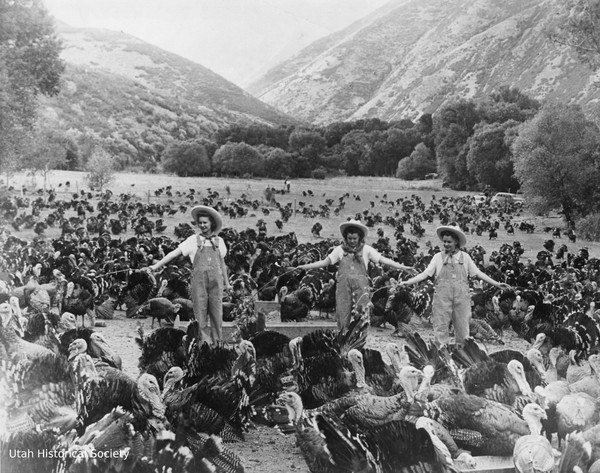Dublin Core
Title
Turkeys: Industrial Change Makes it Everyone’s Bird
Description
This Thanksgiving, you might enjoy a meal that includes a roasted turkey. What are the chances it was born and raised here in Utah?
Few people might associate Utah with one of America’s favorite holiday meals: turkeys. But, the turkey industry in Utah is in fact so big that in 2017 the US Department of Agriculture reported that there were more turkeys in our state than people. From humble beginnings, the turkey industry in Utah now provides birds that are exported to 34 states and 26 countries. Agricultural and industrial developments following World War II boosted the sector, making the bird more easily available to American consumers.
To begin, turkeys are no strangers to this land. Fossils thought to be 76 million year old turkeys have been found in the Grand Staircase-Escalante National Monument in central Utah. Prior to Mormon colonization in 1847, Native Americans farmed domesticated turkeys much like their Euro-American counterparts. When the Mormons came, they could pay church tithing with a turkey -- worth about $2 in the 1850s.
But it was after the 1930s that the Utah turkey industry truly exploded. Many farmers in Utah had originally focused their efforts on growing sugar beets, another major state export. But when massive drought and economic depression led to failing crops, some rural families started to raise turkeys in their yards and basements. It was a risky business. Turkeys were expensive, and considered a luxury by most American families who gathered for Thanksgiving. Turkeys also require extra weather protection and testing for diseases when they are still young. Despite the hassles, raising turkeys was still profitable and became much more widespread with industrialization.
Massive animal processing factories sprung up across the West in the post-war years, and the US Department of Agriculture developed new nutrition and housing guidelines for turkey farmers that made their flocks more successful. Refrigeration meant new sanitary factories with cold storage could process birds by the thousands. Turkeys went from a symbol of high-class refinement to a holiday bird every family could enjoy. The Utah turkey industry persists today as one important contributor to the American Thanksgiving tradition, and an example of how change in rural Utah can lead to surprising innovation.
Few people might associate Utah with one of America’s favorite holiday meals: turkeys. But, the turkey industry in Utah is in fact so big that in 2017 the US Department of Agriculture reported that there were more turkeys in our state than people. From humble beginnings, the turkey industry in Utah now provides birds that are exported to 34 states and 26 countries. Agricultural and industrial developments following World War II boosted the sector, making the bird more easily available to American consumers.
To begin, turkeys are no strangers to this land. Fossils thought to be 76 million year old turkeys have been found in the Grand Staircase-Escalante National Monument in central Utah. Prior to Mormon colonization in 1847, Native Americans farmed domesticated turkeys much like their Euro-American counterparts. When the Mormons came, they could pay church tithing with a turkey -- worth about $2 in the 1850s.
But it was after the 1930s that the Utah turkey industry truly exploded. Many farmers in Utah had originally focused their efforts on growing sugar beets, another major state export. But when massive drought and economic depression led to failing crops, some rural families started to raise turkeys in their yards and basements. It was a risky business. Turkeys were expensive, and considered a luxury by most American families who gathered for Thanksgiving. Turkeys also require extra weather protection and testing for diseases when they are still young. Despite the hassles, raising turkeys was still profitable and became much more widespread with industrialization.
Massive animal processing factories sprung up across the West in the post-war years, and the US Department of Agriculture developed new nutrition and housing guidelines for turkey farmers that made their flocks more successful. Refrigeration meant new sanitary factories with cold storage could process birds by the thousands. Turkeys went from a symbol of high-class refinement to a holiday bird every family could enjoy. The Utah turkey industry persists today as one important contributor to the American Thanksgiving tradition, and an example of how change in rural Utah can lead to surprising innovation.
Creator
By Megan Weiss for Utah Humanities © 2023
Source
Image: Turkey flock near Provo, c 1940. Despite agricultural improvements, rural turkey farmers still faced challenges. Some were economic, such as the increasing costs of importing feed and shipping turkeys to cities. Some were cultural, such as when many Americans chose to fast out of grief following the assassination of President Kennedy in November 1963, which led to an overabundance of turkeys on the market that Thanksgiving. Image courtesy Utah State Historical Society.
_______________
See Dale Adams, “Grasshoppers, Thanksgiving Dinner, and Utah Turkeys,” Utah Historical Quarterly 92, no. 2 (2014); Matt Canham, “Utah Effect: Watch out, people, you’re outnumbered by turkeys,” November 25, 2015, Salt Lake Tribune, accessed October 2023; W. Paul Reeve, A Century of Enterprise: The History of Enterprise, Utah, 1896-1996, (Enterprise, UT: The City of Enterprise, 1996).
_______________
See Dale Adams, “Grasshoppers, Thanksgiving Dinner, and Utah Turkeys,” Utah Historical Quarterly 92, no. 2 (2014); Matt Canham, “Utah Effect: Watch out, people, you’re outnumbered by turkeys,” November 25, 2015, Salt Lake Tribune, accessed October 2023; W. Paul Reeve, A Century of Enterprise: The History of Enterprise, Utah, 1896-1996, (Enterprise, UT: The City of Enterprise, 1996).
Publisher
The Beehive Archive is a production of Utah Humanities. Find sources and the whole collection of past episodes at www.utahhumanities.org/stories.
Date
2023-11-20

